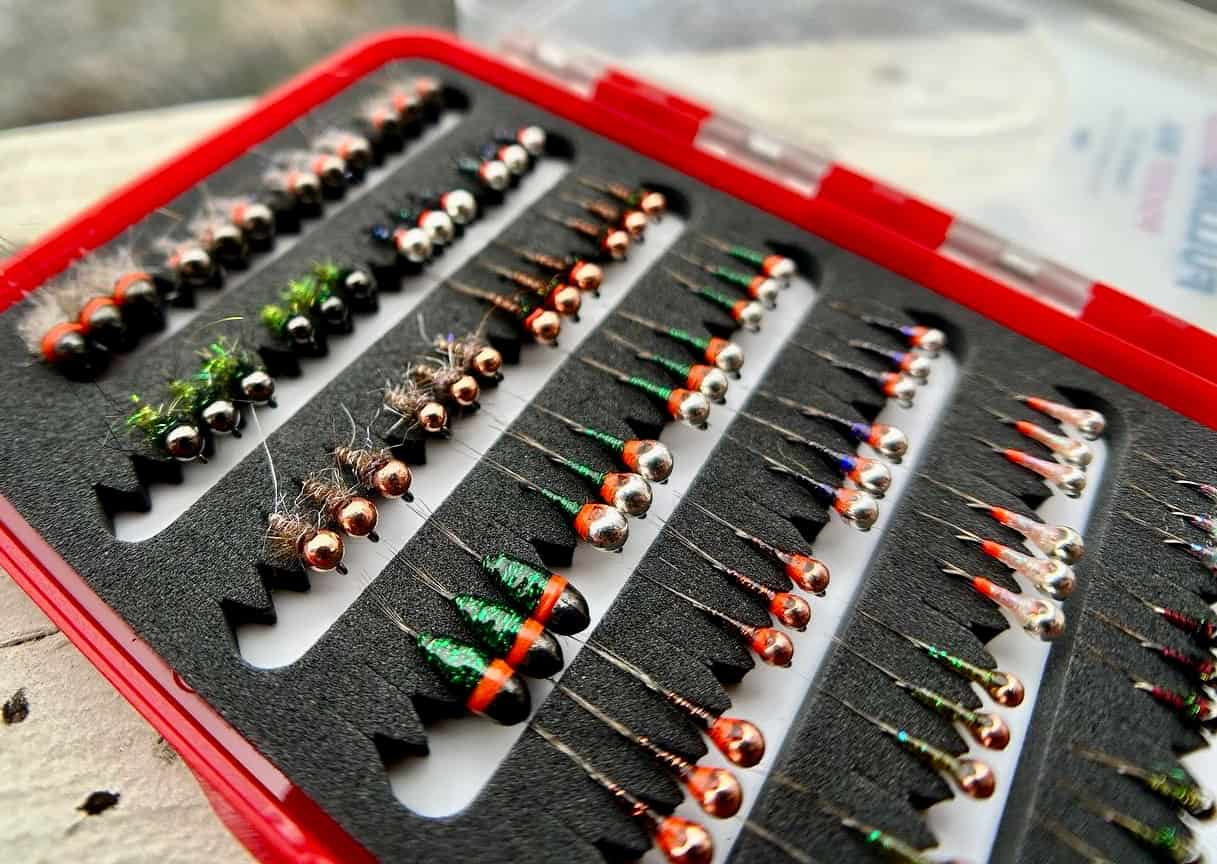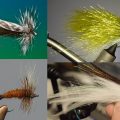Skinny Dippin’: How to Nymph in Shallow Water

Ties and Image by Erik Clymore
No matter how, where, or when you like to trout fish, nymphing is almost always the most productive method. You’re not asking the trout to rise to the surface, chase down your fly, or come to you in any way. Rather, you’re drifting a delectable looking morsal down past a trout’s nose. And like a labrador with spilled kibble, they can’t help but gobble it up. But while many anglers know how to nymph in deep water, very few attempt it in the shallows. They’re missing out.
Shallow-water nymphing is a fantastic way to catch trout in the late season when the water is low, clear and cold, the fish are sluggish, and have pretty much seen it all before. It’s a great way to tempt spooky fish into striking when they’re reluctant to rise or when they’re hanging in fast riffles and won’t move into deeper water. Most anglers believe nymphing in shallow water is just a great way to snag up, break off your favorite flies, and turn already timid trout into lock-jawed phantoms. If you do it right though, it can be your most productive shallow-water fishing method.
Indicator Nymphing in Shallow Water
As the old saying goes, “when in doubt, put on a bobber,” and this has a lot of merit when it comes to shallow-water nymphing. Trout that are holding and feeding in shallow water can have delicate takes and often barely move from their feeding lanes to take food from the current. A strike indicator can be extremely helpful in these situations, but be selective about your set up.
Most indicators are designed for drifting through deep water and are large enough to hold multiple flies and a split-shot dappled line high in the water column without sinking. In shallow water these larger indicators splash down like a beach ball and stand out like massive glowing orbs causing the fish to fear an alien abduction. They’ll scoot out of the way of these larger indicators, usually well before they’ve seen your flies drifting underneath. Downsize your indicator.
Choose a small plastic or cork indicator, such as the smallest size Thingamabobber, that’s a 1/2-inch in diameter or less. A wool or hair indicator can also be used. It’s important to remember, especially in shallow clear water, to choose an indicator that looks natural. Stay away from fluorescent colors and stick to white, brown, black or completely clear.
Aside from the indicator, shallow water nymphing also requires lighter, fluorocarbon tippet and little to no weight. This is both so that the flies look and drift as naturally as possible and so you don’t spend most of your time trying to get your flies back from the rocks and sticks. Instead of split shot, rely on lightly weighted bead head fly patterns to get your bugs down where they need to be. Try pairing a larger Beadhead Pheasent Tail, Beadhead Hares Ear, and other natural looking flies with unweighted flies like a Hunchback or a WD-40 as droppers. The heavier fly on top will help keep your presentation down and controlled in the drift while the smaller lighter fly will be free to roam and wiggle tantalizingly as it’s pulled along. This gives the trout the option to eat one or the other or even both if they’re feeling squirrely.
Tightline Nymphing in Shallow Water
Whether you call it tightlining or Euro-nymphing, drifting nymphs on a tight line is an incredibly effective way to fish shallow water. It’s done by casting your flies without an indicator and then holding the rod high—following your drift and maintaining constant contact with your flies. It’s a favorite method for competitive fly anglers to catch numbers as it allows you to repeatedly drift flies past trout time after time with little effort. Generally, tightlining is done in faster, deeper holes with a leading weight and a sighter on your mainline that lets you know when a trout eats. However, when fishing in shallow water, this rigging isn’t necessary.
When you’re tightline nymphing in shallow water, the only thing you really need is a couple of flies and your standard monofilament leader. Choose a lighter leader in the 5x to 7x range which has a thinner diameter and will cut through water more easily, giving you a more natural drift based on the movement of the flies and not water pushing against the line. When using this lighter line, be more delicate with your hooksets to avoid breaking off fish.
The rigging and flies you choose for tightlining in shallow water are vital for success. Tie a 6-inch to 10-inch length of tippet onto your line using a double surgeons knot, leaving a long tag end. Choose a heavier, jig-style bottom fly that won’t get snagged as easily such as a Jig Sticker or a Sowbug which should be tied to the bottom of the added tippet. Tie a lighter, smaller fly such as a Rojo Midge, Flashback Hares Ear, or even a soft hackle like a Red Ass to the tag end of the knot. This set up gives the trout multiple options in both depth and fly style. If it’s legal where you fish, you can also add a third fly to the rig to make sure you have all your bases covered.
Fish your shallow tightline rig in faster water by making your cast and then quickly mending to give the fly a few seconds to sink. Once you feel the jig-style fly hit bottom, raise your rod tip to maintain contact with the flies and follow them downstream with the rod tip. Strikes will come as a hard tug on the line, a slight twitch or bump, or even a simple hesitation or pause in the drift. Whenever any of these things occur, set the hook.
Working on the Line
Nymphing is always going to be the go-to method for many anglers because it’s your best chance of catching a trout in almost every situation. When you learn to nymph the shallows, you’re transforming it from a fallback method to a legitimate and skillful technique in every circumstance. It gives you an ace in the hole no matter how little water you have to work with or how tough the fishing gets.











